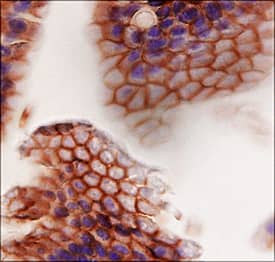Mouse ErbB2/Her2 Antibody
R&D Systems, part of Bio-Techne | Catalog # AF5176

Key Product Details
Species Reactivity
Validated:
Cited:
Applications
Validated:
Cited:
Label
Antibody Source
Product Specifications
Immunogen
Thr23-Thr653
Accession # P70424
Specificity
Clonality
Host
Isotype
Scientific Data Images for Mouse ErbB2/Her2 Antibody
ErbB2/Her2 in Mouse Intestine.
ErbB2/Her2 was detected in perfusion fixed frozen sections of mouse intestine using Sheep Anti-Mouse ErbB2/Her2 Antigen Affinity-purified Polyclonal Antibody (Catalog # AF5176) at 1.7 µg/mL overnight at 4 °C. Tissue was stained using the Anti-Sheep HRP-DAB Cell & Tissue Staining Kit (brown; Catalog # CTS019) and counterstained with hematoxylin (blue). Specific staining was localized to plasma membranes. View our protocol for Chromogenic IHC Staining of Frozen Tissue Sections.Applications for Mouse ErbB2/Her2 Antibody
Immunohistochemistry
Sample: Perfusion fixed frozen sections of mouse intestine
Western Blot
Sample: 3T3‑L1 mouse embryonic fibroblast adipose-like cell line.
Formulation, Preparation, and Storage
Purification
Reconstitution
Formulation
Shipping
Stability & Storage
- 12 months from date of receipt, -20 to -70 °C as supplied.
- 1 month, 2 to 8 °C under sterile conditions after reconstitution.
- 6 months, -20 to -70 °C under sterile conditions after reconstitution.
Background: ErbB2/Her2
ErbB2, also called Neu and Her2 (human epidermal growth factor receptor 2), is a 185 kDa type I transmembrane glycoprotein that is a member of the ErbB family of tyrosine kinase receptors for EGF superfamily growth factors. ErbB2 is widely expressed in epithelial cells and plays roles in development, cancer, communication at the neuromuscular junction, and regulation of cell growth and differentiation. The mouse ErbB2 extracellular domain (amino acids 23-653 of 1256) shares 85% and 94% aa identity with human and rat ErbB2 ECD, respectively. The protease ADAM10 releases a 110 kDa soluble fragment of ErbB2 from the cell surface. ErbB2 has no identified ligands, but heterodimerizes with ErbB1 (EGF R), ErbB3, or ErbB4 to form higher affinity signaling complexes. The ErbB2/ErbB3 heterodimer is expressed in the majority of breast, skin, ovary and gastrointestinal tumors and transduces a highly mitogenic signal in response to neuregulin 1 (NRG1; heuregulin 1) or NRG2.
Long Name
Alternate Names
Gene Symbol
UniProt
Additional ErbB2/Her2 Products
Product Documents for Mouse ErbB2/Her2 Antibody
Product Specific Notices for Mouse ErbB2/Her2 Antibody
For research use only
